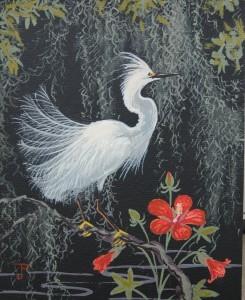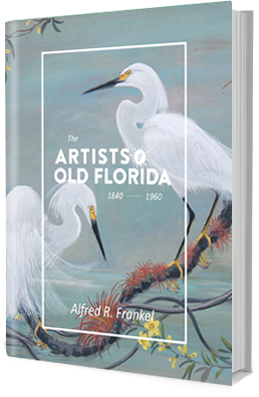For over fifty years Joy Postle painted the birds of Florida. the people of Orange County called her the Bird Lady, and, with her thin sharply defined features, pretty face, angular chin, carefully clipped hairdo, her head tilted aside, she was. But beautiful too! Hundreds of artists have used Florida’s bird life as their subject. Joy Postle ranks with the best.
I first met her in an antique shop at the north end of fourth Street in St. Petersburg about fifteen years ago. In a small alcove, leaning against the wall was a Florida landscape, watercolor and tempera, of a cypress lined lake. With egrets in flight, it caught my eye. An Orlando Sentinel article taped to the back told me about the artist. “Some people flat out don’t believe it when Joy Postle Blackstone tells them she once crouched quietly in the Everglades and watched a tiger swallowtail butterfly land on a Florida panther’s tail…In the 1940’s while Marjory Stoneman Douglas began battling to save the Everglades and Marjorie Kinnan Rawlings became intrigued by rural Florida at Cross Creek, Joy Postle…began capturing Florida wildlife on canvas.”
Postle was born in Chicago in 1896 and studied at the Art Institute of Chicago from 1915 to 1917 on a scholarship. As a young woman she lived on a ranch on the Snake River Plateau in Idaho where she rode horseback, painted, and taught art and music in rural country schools. When Postle opened a studio in Boise a reporter, Robert Blackstone, called for an interview. A year later, in 1928, the couple were married and began a roaming honeymoon through the southwest in a small house car fitted as an artist’s studio. One freezing morning Postle pulled out her watercolors to paint a scene at Utah’s Zion Park and the watercolors froze.
They headed to Florida, arriving in Pensacola in 1931. Postle opened a studio at the San Carlos Hotel and painted a series of murals there, described in an 1932 issue of the Pensacola Journal. “I don’t know what the San Carlos paid Joy Postle for her work, but whatever it was, it was worth it. She has put the very spirit of Pensacola into the San Carlos Hotel and has painted some Pensacola scenes that are more than lovely. There is one that makes you catch your breath. You just know that she painted it early one morning some weeks ago just after she had been there to see this bit of water and cliff and woodland in all their breathless beauty…Nearby, just a bit of contrast, there is Pensacola beach on Santa Rosa Island as it is today. With gay modernistic umbrellas and lounging ladies… there are other historical and woodland pictures here and there suggesting the past that is historic, and the present that is so beautiful…I love every sprawling vine she has pained and every little smug flower pot, all the color and gaiety. But what I love most of all is what she has tried to say, and said so well…she has pictured a background of valor and pomp and power, and something of strength against which the colors gleam and the vines form their graceful tracery.”
Postle and her husband left Pensacola to travel about the state, exploring the Keys, the Everglades, Ocala and Silver Springs. She fell in love with Florida’s wading birds.
In 1937, while living in Ocala, Postle was appointed artist-teacher on the staff of the University Federal Gallery at Camp Roosevelt. She, like many artists during the Depression, worked for the Florida Art Project of the Works Project Administration.
In 1942 the couple moved to Orlando and Lake Rose out on the Old Winter Garden Road. Here she and Bob Blackstone made plans for an entertainment, a Glamour Bird act. Blackstone recorded birds chirping while Postle played the piano, and then used these sounds to accompany Postle, as she painted birds for an audience. Beethoven’s Moonlight Sonata accompanied her as she sketched night heron’s. Brahms Lullaby played as she added a nest to a picture, recited poetry, sang, danced, and painted the Glamour Birds of Florida. Art Digest, quoted her, “A painting is a dance performed with brush and pigment on a stage of canvas. It must be spontaneous and joyous, as a dance.”
During World War II Postle gave performances of her Glamour Birds at Army and Navy Hospitals across the country. A pamphlet put out by Blackstone and Postle describes her work. “Joy Postle brings the mysterious swamps and waterways of the America’s to her audiences in songs, witty stories, original verse, and pictures…She brings the perfume of wild flowers, the spell of the woods and fields as she sings, and draws the wading birds, life size in color…She gives vivid descriptions of their almost human ways of courting, dancing, and home building. Their eggs seem to hatch out before your eyes…You laugh at their comical antics, and hold your breath as they face danger.”
Postle captured Florida wildlife on canvas. She waded through swamps, climbed trees, endured bugs and stayed up all night to observe her subjects. She brought the wilderness to the city by painting panoramic murals on buildings scattered around Central Florida. On Lake Rose the Blackstone’s took moonlight canoe rides to listen to the whooshing of nighthawk wings as the birds dove for bugs, or to look in on a rookery of black-crown night herons.
For years the Bird Lady danced and painted, from Jacksonville to Miami, from Sarasota to Tampa and up to Gainesville, all over the state. In 1968 a dripping kerosene heater started a fire that killed Bob Blackstone, put Postle in the hospital for fourteen months and destroyed their home and many paintings.
In May of 1969 the Kissimmee Junior Woman’s club and the local branch of the Beta Sigma Phi sorority, sponsored a Show For Joy, and later a Paint For Joy, with all funds going to Postle, for a new burn treatment and for repair of her studio. Joy’s eyes were damaged, but after a series of operations, she returned to painting in April 1969. The Florida Federation of Art sponsored a public demonstration of her art at the Deltona Community Center. The Bird Lady and her Glamour Birds were back.
Postle was not just a painter of birds, she was an avid advocate for nature conservation. Her letter to the Orlando Sentinel Star, August 12, 1973, “It is a fact that DDT has developed races of super mosquitoes and cockroaches which nothing will kill, short of a well aimed brick…it is also a fact not to be ignored that the wonder pesticides have caused the death of millions of fish, wild animals, birds, even valuable domestic animals, not to mention quite a few people…No name calling can discredit Rachel Carson’s Silent Spring.”
Postle’s life was her art. She continued to paint and write poetry into her 90’s, sometimes from a wheelchair. When she died in June 1989, at the age of ninety-three, she was renowned in central Florida for her art work. Today her legacy of Florida wildlife art is almost forgotten.
 Well that’s Joy Postle. I hope you enjoyed meeting her. It was a privilege for me to introduce you. Someday when your out antiquing perhaps you’ll meet her again.
Well that’s Joy Postle. I hope you enjoyed meeting her. It was a privilege for me to introduce you. Someday when your out antiquing perhaps you’ll meet her again.



